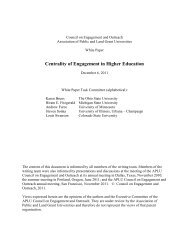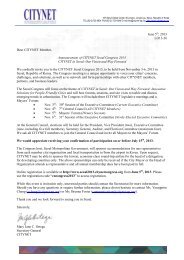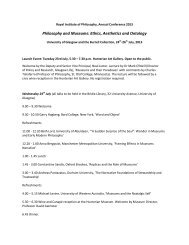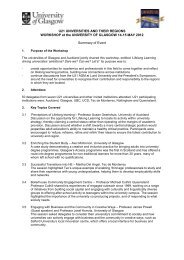Finland - Jyvaskyla Region - Final Self-Evaluation Report.pdf
Finland - Jyvaskyla Region - Final Self-Evaluation Report.pdf
Finland - Jyvaskyla Region - Final Self-Evaluation Report.pdf
You also want an ePaper? Increase the reach of your titles
YUMPU automatically turns print PDFs into web optimized ePapers that Google loves.
ut the detailed contents are determined regionally. This two-level system is very reasonable as awhole, but it is also vulnerable to conflict. The national and regional level aspirations do notnecessarily coincide, which may cause collision of national and regional strategies. Therefore, it isvery important that national and regional level actors interact continuously and that the coherence ofstrategies is ensured by particularly careful preparations.2. The challenges of the Finnish dual system. The Finnish higher education is based on a dual systemof two different types of institutions: universities and polytechnics. The dual system is rather new,and the experiences gained of the system are still minor. However, a system based on two parallelsectors brings about both challenges and opportunities from the viewpoint of the regionalcontribution of HEIs. Firstly, intensive cooperation of the two parallel sectors is needed to ensureefficient allocation of resources. Herein, the question is not only about division of work betweenthese two organizations, but also about how these organizations are able to complement and supporteach other in the regional arena. The key factors for successful cooperation are mutual respect andconfidence. Without these cornerstones, the cooperation remains at the minimum level. Secondly,the dual system is based on different profiles and roles of universities and polytechnics. Hence, thecontributions of the HEIs to regional development are determined endogenously by the dual systemitself. The polytechnics are strongly connected to regional working life and industry. The dominatingfactor in the role of polytechnics in the social arena is their ability to respond to regional demand anddevelop their operations in a reciprocal manner with the local socio-economic environment.However, the universities are tightly connected to the national innovation system and internationalcompetitiveness of the nation. This aspect dominates the role of universities in the social arena.Therefore, the contribution of universities to regional development is strongly dependent on thedefinition of national policies. The role of universities in regional socio-economic systems is tocontribute to the local utilization of their expertise based on national level aspirations. Thesedifferent starting points of universities and polytechnics should be carefully considered indetermining the regional strategies of HEIs. Thirdly, the evaluation of the contribution of HEIs toregional development involves special issues to be addressed in a dual system. The evaluation shouldfocus especially on the interfaces and vertical structures of these separate institutions.3. The changing environment of HEIs. Until recently, the aim of ensuring opportunities for highereducation regardless of the geographical location of individuals has been strongly emphasized by thenational HE-strategies. This emphasis has lead to the decentralization of HEIs and their operations aswell as to aspirations for versatility rather than specialization in the individual HEIs. However,mainly due to strengthening globalization and strong demographic changes expected, the HE-systemnow confronts totally new challenges. Strengthening globalization intensifies competition betweencountries, regions and HEIs, and furthermore, also accelerates processes of specialization andlearning economies. The globalization process has forced the HE system to reshape its priorities.Ability to be globally competitive is nowadays the topmost definition of the HE policy in <strong>Finland</strong>. Inaddition to globalization, the demographic changes also cause pressures for a renewal of the HEsystem.The age groups entering education will gradually decrease in the near future. This will causenecessary reductions and require more focused activities of the HE-sector. Depending on the regionconsidered, the phenomena described above may have considerable effects on the role of HEI inlocal socio-economic development. In any case, these margin conditions should be identified andtaken into account when planning strategies and measures for improving the contribution of HEIs toregional development. In practice, this means further specialization, division of labour andprioritizing of activities. The major task is how the HEIs are able to manage simultaneously theincreasing external pressures to make their operations more efficient and the growing expectationsfor their role in the social, cultural and economic development of society.4. Dynamics of HEIs. HEIs are facing a vast number of demands and expectations due to the rapidchanges in their environment. The higher education system can be considered to be quite inflexiblecompared to the fast changes in the local socio-economic environment they operate in. Naturally,some amount of rigidity is even necessary to ensure sustainability of the regional developmentprocesses. However, sometimes a fast reaction is needed and the HE system should be able torespond to the short run needs of the surrounding region. Anticipation and new ways of organizingthe operations are preconditions for a more dynamic HE system. Anticipation should be able to39










